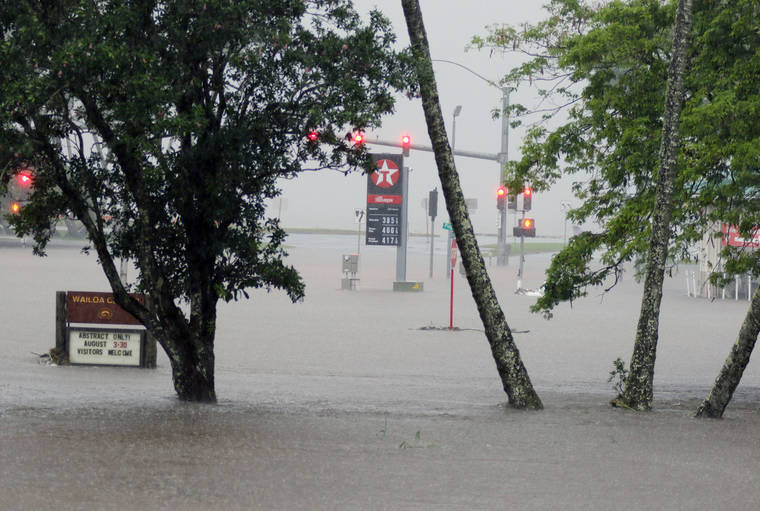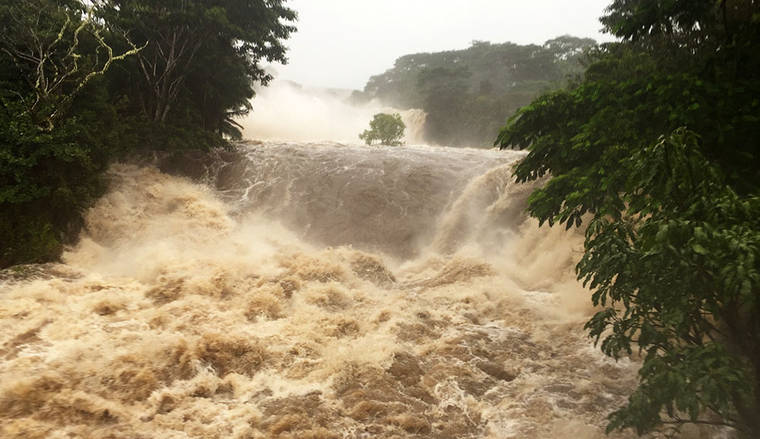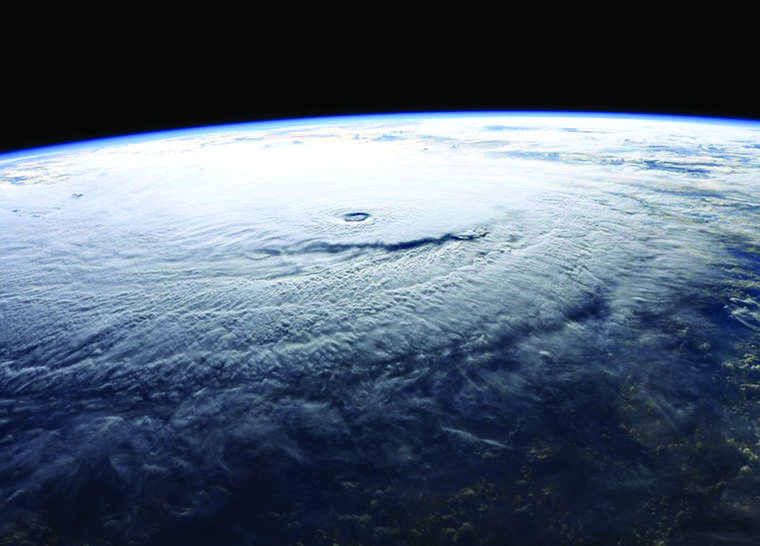Hurricane season ahead: Forecast calls for 2-6 tropical cyclones in Central Pacific

Hilo’s Bayfront and the entry to Wailoa Center were flooded in August 2018 as Hurricane Lane passed west of the Big Island. (TIM WRIGHT/Hawaii Tribune-Herald file)

Wailuku River flooding is seen Aug. 23, 2018, near Hilo as Hurricane Lane passed the Big Island. (Jessica Henrick/AP photo)

Hurricane Lane is seen Aug. 22, 2018, from the International Space Station. (RICKY ARNOLD/NASA photo/file)
Forecasters are calling for near- to below-normal tropical cyclone activity within the Central Pacific this hurricane season.
Forecasters are calling for near- to below-normal tropical cyclone activity within the Central Pacific this hurricane season.
Two to six tropical cyclones — a category that includes depressions, storms and hurricanes — are expected to pass through the basin this year, said Chris Brenchley, director at NOAA’s Central Pacific Hurricane Center in Honolulu. The 2020 season starts June 1 and runs through Nov. 30.
The basin, which normally sees four to five cyclones, spans an area north of the equator from 140 degrees west longitude to the International Date Line. The number of storms has ranged from zero, most recently as 1979, to as many as 16 in 2015.
“This year we will likely see less activity in the Central Pacific region compared to more active seasons,” said Gerry Bell, NOAA’s lead seasonal hurricane forecaster at the Climate Prediction Center. “Less activity is predicted since ocean temperatures are likely to be near-average in the central and eastern Pacific Ocean where hurricanes form, and because El Nino is not present to increase the activity.”
In the center’s 2020 outlook, forecasters said there’s a 75% chance of a near- to below-normal season, and a 25% chance of an above-normal season.
The prediction is based on currently neutral El Nino conditions persisting through at least August before a 50-50 chance of the neutral conditions tilting toward La Nina conditions later in the season, Brenchley said. La Nina conditions are typically correlated with below-normal activity.
“Again, there’s higher-than-normal uncertainty, especially as we go later in the year and this is due to the fact that the climate models are showing indications both ways of having neutral or La Nina conditions, and depending on that, it could modify the expectations as we go forward (in the season),” he said.
Named Central Pacific tropical cyclones for 2020 will begin with “Hone,” according to the center.
Last year, forecasters called for an above-normal season with five to eight tropical cyclones impacting the basin. Just four tropical cyclones passed through the area; one reached hurricane strength. None directly impacted Hawaii.
Brenchley said Wednesday that El Nino conditions tapered off earlier than expected, likely resulting in fewer storms than initially forecast for 2019.
Whether there’s one or a record-breaking 15, the time to get storm-ready is upon us with the official start of hurricane season days away.
“We have to keep in mind that what would we do? Are we prepared if one of those tropical cyclones — just one of them — were to hit our home? I think that’s the important take away, not the number of cyclones; it’s very regardless of the number of cyclones that are predicted,” said Brenchley. “It’s just a reminder to all of us — the citizens here in the State of Hawaii to be prepared and to prepare now.”
Hawaii Emergency Management Agency Administrator Luke Meyers outlined the agency’s “six calls of action” for the community, on top of what is already being done amid the COVID-19 pandemic.
“We are in a marathon and when we overlay hurricane season onto this marathon, it’s going to turn into a triathlon, so we really need to be prepared,” he said.
The “actions” are knowing surrounding hazards, such as areas where flash flooding can occur; signing up for alerts; developing an emergency plan; purchasing flood insurance and retrofitting homes for storms; and restocking and adding new items to 15-day emergency supply kits.
“For this year, we want you to include masks and hand sanitizers,” Meyer said. “Those are traditionally items that we have never included in our 15-day kits, which we want you all to include.”
Lt. Gov. Josh Green, a practicing Kohala ER physician, added the public shouldn’t be complacent or reluctant to follow instructions and should help one another. People should also check on medication supplies. With 60% fewer people going to doctors and hospitals for basic services amid COVID-19 restrictions, many may not have a two-week supply on hand.
“This is probably a very good time to remind people of being stocked up on their medications … we would really not want to see people go a long period of time without their medications,” he said.
Recommended items for an emergency supply kit can be found on the American Red Cross website at www.redcross.org/get-help/how-to-prepare-for-emergencies/survival-kit-supplies.


